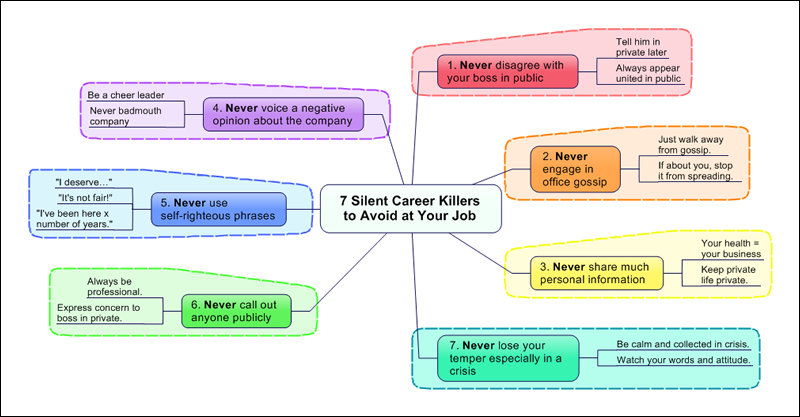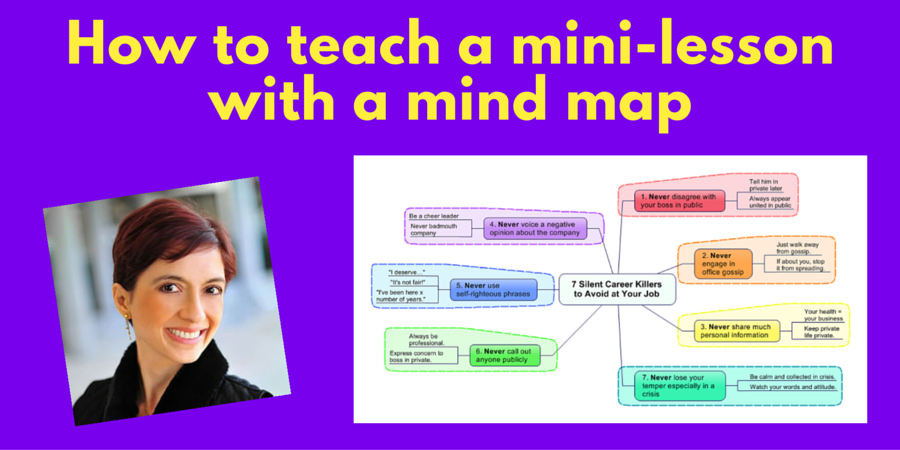Farnoosh Brock’s excellent instructional mind map on career mistakes to avoid “breaks” several rules of mind mapping, but that’s OK. It communicates a mini-lesson very effectively.
Traditional mind maps only have a single word or several words at the most on each branch. But Farnoosh “breaks the rules” by employing short, complete sentences to provide a clear, concise mini-lesson on work behaviors to avoid. By starting at the 12 o’clock position and reading around the map in a clockwise fashion, you get a complete understanding of how to avoid these mistakes. It’s an engaging visual exercise.
 If you feel inspired to create something similar, keep these tips in mind:
If you feel inspired to create something similar, keep these tips in mind:
- Be very clear in your mind what the progression of information should be. What should people read first? Next? After that?
- Invest time thinking about how to express your key points as concisely and clearly as possible. Remember, you have the full context behind the map in your mind. The people who will be viewing your mind map won’t. They can only go on the words in your topics and the sequence and hierarchy in which you’ve arranged them.
- Preview your mind map with several people who you can count upon to give you honest feedback. What don’t they understand about it? What needs to be clarified or explained better?
Who is Farnoosh Brock?
 Farnoosh is the passionate founder and president of Prolific Living, a blog and consultancy that helps executives break out of stagnating careers and ignite their entrepreneurial spirit. I’ve known her for a number of years, and have always been impressed by her passion, her ability to inspire others and her incredible generosity.
Farnoosh is the passionate founder and president of Prolific Living, a blog and consultancy that helps executives break out of stagnating careers and ignite their entrepreneurial spirit. I’ve known her for a number of years, and have always been impressed by her passion, her ability to inspire others and her incredible generosity.
I asked Farnoosh how she uses mind mapping in her business. Here’s what she had to say:
“Visual communication is one of many ways to convey information, but it is a powerful one if it applies to the topic at hand” – such as a self-contained mini-lesson on a business or personal topic.
Farnoosh also loves how mind mapping supports brainstorming, but also distilling, organizing and sharing information in an organized way:
“Mind maps are extremely useful in brainstorming of ideas and in organization of thoughts and consideration of all possibilities when looking at solutions and assimilation of information,” she explains.
It’s also a powerful tool for capturing discussions with her consulting clients:
“You can get very creative with mind maps. Often, you will have more ideas coming out of a mind map than you first thought of putting into it. I use this exercise with my clients – as applicable – and the outcome is generally inspiring and powerful, not to mention that it gives them a guide or a ‘map’ to go by!” she adds.
I couldn’t have said it better myself! I can see a mind map would enable Farnoosh and her clients to capture, organize and consider a whole range of possibilities and then to discuss and evaluate them effectively. Best of all, and the end of a consulting session, she can print out or email her client the completed map, which he or she can use to get started.
Brilliant!


Leave a Reply